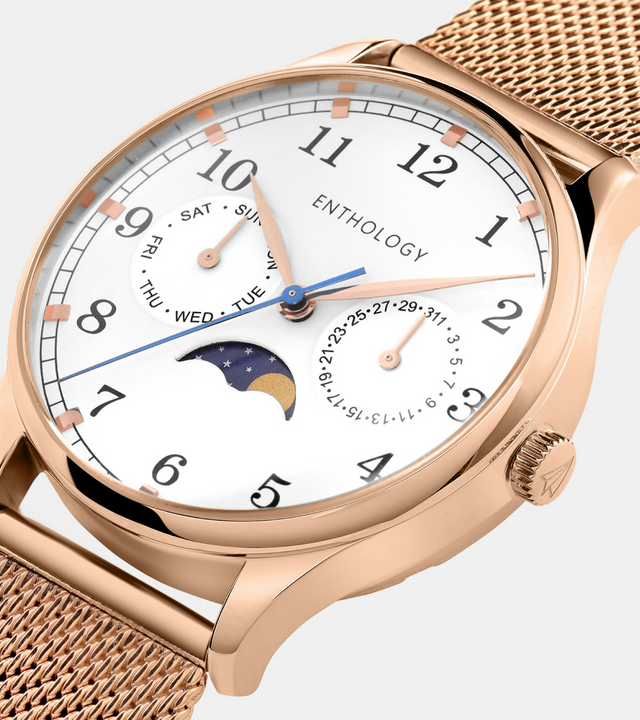What's a moonphase watch?
What's a moonphase watch?
I first fell in love with watches a few years ago. Back then, although companies made watches for women, very few ever made those watches with complications. They would instead make the watch with a beautiful strap or load the bezel with diamonds and present them as watches women should wear. Times are changing and more companies are realizing that there are women who love watches with complications.

A moonphase complication
A watch with “complications” is a watch that does more than tell time. Before companies decided to be more aesthetically creative with the watches they make for women, most women’s watches would be limited to just the two hands that point to an hour and a minute. On occasion, you’d see the date. But that’s it.
When we decided to launch Enthology’s collection of watches for women, incorporating the moon phase complication into our collection, we wanted to lead a revolution in the watch industry as a company who understands a beautiful and elegant premium women's watch doesn’t just mean diamonds on the bezel. The moon phase is one of my favorite complications and always adds a touch of artistry and a bit of astronomy to any watch.

Enthology's Disorganised Symphony Collection
Wearing a watch with a moon phase on the dial means that at any given time, you can flick your wrist to see the current phase of the moon. Is the moon waxing, which means the moon is working its way into becoming full? Or waning, which means the full moon has already passed? These answers are always readily available to you with a glance.
The Moonphase Complication
Moon phases first appeared in horology (the art of making clocks and watches) during the Renaissance period, where clocks displayed various moon designs. The complication itself was a feat of engineering - to get the feature to work, a device had to be connected to the hour hand and that device would then be programmed to turn another device once every 24 hours. This second device is the disc we see displaying each phase of the moon.

A timeless moon phase complication on a vintage Omega
The round disc has 59 grooves, with each groove accounting for a 24-hour period of time. Consequently, it takes 59 days for the disc to complete a full rotation. Two different moons are painted at the 12 o’clock and 6 o’clock mark, one to represent the full moon and the other to represent the new moon. When you see a complete moon on your watch, it means 29.5 days have passed, which is the equivalent of a lunar month.
The days leading up to the 29.5 day mark are the waning period and the watch shows just a percentage of one of the moon’s painted on the disc. The days following the 29.5-day mark represent the waning period, and you again start seeing only a percentage of the disc’s moon. You’ll always see a complete moon on day 29.

A moon phase disc from luxury maker, A. Lange & Söhne
Studying the engineering behind complications such as this made me fall head over heels with the watch industry. And the more complicated a watch is, which is determined by the number of complications a watchmaker adds to his design, the more enamored I am.
Enthology's take on the Moonphase
While the moon phase is definitely my number one favorite in our watches, we decided to step up our game by adding two more complications that most people don’t realize adds to the complexity of the watch design.

A close up of Enthology's moonphase and day-date complication
Enthology's watches come with what’s known as a day-date complication. Many watches come with a basic date complication, which, simply stated, is the numerical day of the month. A day-date, however, makes the engineering behind a watch more challenging as this complication tells both the numerical day of the month as well as the actual day of the week.
Just as with the moon phase complication, the day-date feature also requires the coordination of two different gears within the watch movement. A watch “movement” is the guts of a watch. It’s all the moving parts that help the watch tell time. The two different gears of the day-date must also interact with the hands of the watch as these gears need to know when a 24-hour period of time has passed in order to do their job.
Now, consider what you’ve just read about the day-date complication, then add what you’ve read about the moon phase complication and take a moment to scratch your head a bit as you wonder how all of this happens within a case that’s only 36mm in diameter!

36mm size which neither overwhelms or understates
Such engineering is typically only found in the big brands, such as Patek Philippe or Audemars Piguet. In fact, Patek Philippe was one of the first watch manufacturers to incorporate a moon phase complication into their watches for women, back in 1925.
We're now following in that tradition with our Disorganised Symphony collection. From the complicated movement that makes up the interior of the watch, to the 316L stainless steel and sapphire crystal that ensures the watch glass will never break no matter how rough your day, these watches may look like fun, but they're clearly not here to play.
Add that I can easily change the watch’s strap to any color that suits my fashion choice of the day, and I have an accessory that makes me look stylish as I impress people with stories about just how complicated this contraption on my wrist is.
Browse Watches

